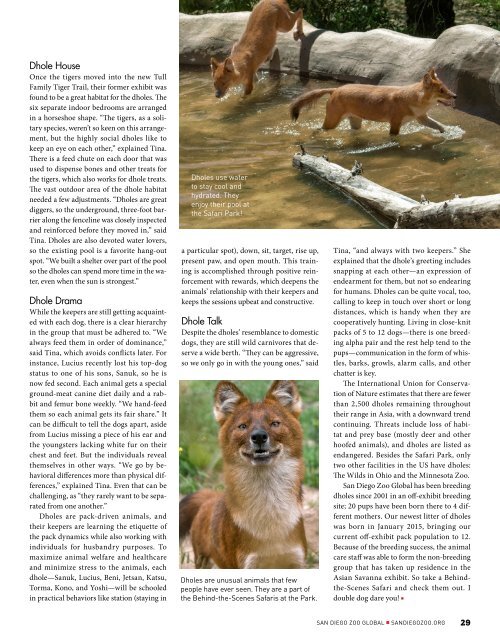You also want an ePaper? Increase the reach of your titles
YUMPU automatically turns print PDFs into web optimized ePapers that Google loves.
Dhole House<br />
Once the tigers moved into the new Tull<br />
Family Tiger Trail, their former exhibit was<br />
found to be a great habitat for the dholes. The<br />
six separate indoor bedrooms are arranged<br />
in a horseshoe shape. “The tigers, as a solitary<br />
species, weren’t so keen on this arrangement,<br />
but the highly social dholes like to<br />
keep an eye on each other,” explained Tina.<br />
There is a feed chute on each door that was<br />
used to dispense bones and other treats for<br />
the tigers, which also works for dhole treats.<br />
The vast outdoor area of the dhole habitat<br />
needed a few adjustments. “Dholes are great<br />
diggers, so the underground, three-foot barrier<br />
along the fenceline was closely inspected<br />
and reinforced before they moved in,” said<br />
Tina. Dholes are also devoted water lovers,<br />
so the existing pool is a favorite hang-out<br />
spot. “We built a shelter over part of the pool<br />
so the dholes can spend more time in the water,<br />
even when the sun is strongest.”<br />
Dhole Drama<br />
While the keepers are still getting acquainted<br />
with each dog, there is a clear hierarchy<br />
in the group that must be adhered to. “We<br />
always feed them in order of dominance,”<br />
said Tina, which avoids conflicts later. For<br />
instance, Lucius recently lost his top-dog<br />
status to one of his sons, Sanuk, so he is<br />
now fed second. Each animal gets a special<br />
ground-meat canine diet daily and a rabbit<br />
and femur bone weekly. “We hand-feed<br />
them so each animal gets its fair share.” It<br />
can be difficult to tell the dogs apart, aside<br />
from Lucius missing a piece of his ear and<br />
the youngsters lacking white fur on their<br />
chest and feet. But the individuals reveal<br />
themselves in other ways. “We go by behavioral<br />
differences more than physical differences,”<br />
explained Tina. Even that can be<br />
challenging, as “they rarely want to be separated<br />
from one another.”<br />
Dholes are pack-driven animals, and<br />
their keepers are learning the etiquette of<br />
the pack dynamics while also working with<br />
individuals for husbandry purposes. To<br />
maximize animal welfare and healthcare<br />
and minimize stress to the animals, each<br />
dhole—Sanuk, Lucius, Beni, Jetsan, Katsu,<br />
Torma, Kono, and Yoshi—will be schooled<br />
in practical behaviors like station (staying in<br />
Dholes use water<br />
to stay cool and<br />
hydrated. They<br />
enjoy their pool at<br />
the Safari Park!<br />
a particular spot), down, sit, target, rise up,<br />
present paw, and open mouth. This training<br />
is accomplished through positive reinforcement<br />
with rewards, which deepens the<br />
animals’ relationship with their keepers and<br />
keeps the sessions upbeat and constructive.<br />
Dhole Talk<br />
Despite the dholes’ resemblance to domestic<br />
dogs, they are still wild carnivores that deserve<br />
a wide berth. “They can be aggressive,<br />
so we only go in with the young ones,” said<br />
Dholes are unusual animals that few<br />
people have ever seen. They are a part of<br />
the Behind-the-Scenes Safaris at the Park.<br />
Tina, “and always with two keepers.” She<br />
explained that the dhole’s greeting includes<br />
snapping at each other—an expression of<br />
endearment for them, but not so endearing<br />
for humans. Dholes can be quite vocal, too,<br />
calling to keep in touch over short or long<br />
distances, which is handy when they are<br />
cooperatively hunting. Living in close-knit<br />
packs of 5 to 12 dogs—there is one breeding<br />
alpha pair and the rest help tend to the<br />
pups—communication in the form of whistles,<br />
barks, growls, alarm calls, and other<br />
chatter is key.<br />
The International Union for Conservation<br />
of Nature estimates that there are fewer<br />
than 2,500 dholes remaining throughout<br />
their range in Asia, with a downward trend<br />
continuing. Threats include loss of habitat<br />
and prey base (mostly deer and other<br />
hoofed animals), and dholes are listed as<br />
endangered. Besides the Safari Park, only<br />
two other facilities in the US have dholes:<br />
The Wilds in Ohio and the Minnesota Zoo.<br />
San Diego Zoo Global has been breeding<br />
dholes since 2001 in an off-exhibit breeding<br />
site; 20 pups have been born there to 4 different<br />
mothers. Our newest litter of dholes<br />
was born in January <strong>2015</strong>, bringing our<br />
current off-exhibit pack population to 12.<br />
Because of the breeding success, the animal<br />
care staff was able to form the non-breeding<br />
group that has taken up residence in the<br />
Asian Savanna exhibit. So take a Behindthe-Scenes<br />
Safari and check them out. I<br />
double dog dare you! n<br />
SAN DIEGO ZOO GLOBAL n SANDIEGOZOO.ORG<br />
29



